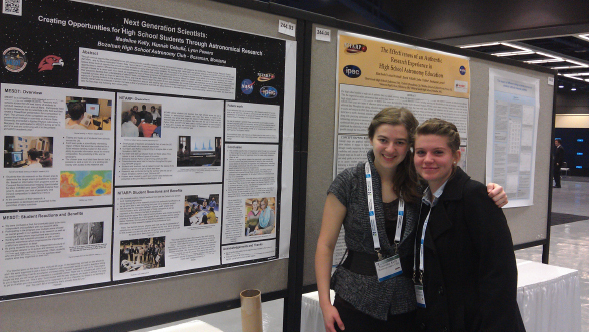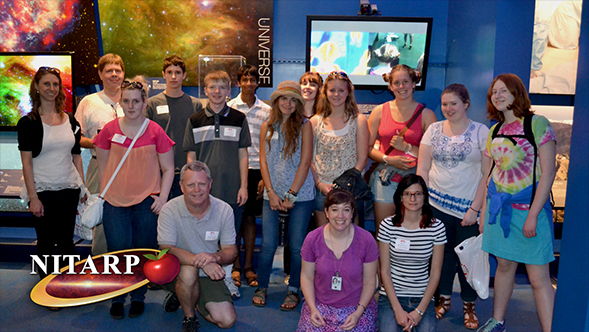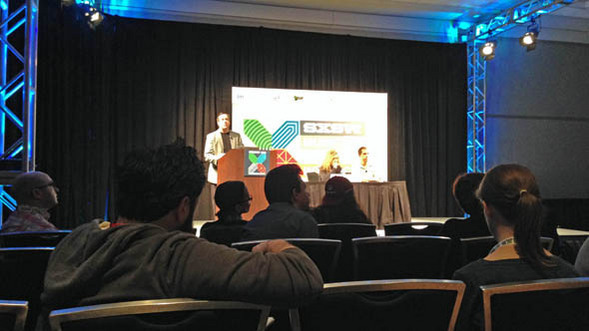
By Madie Kelly & Hannah Cebulla | April 20th, 2015
What started as an exciting opportunity to get a glimpse into the world of astronomical research became a part of our lives that is now incredibly central to our passions and future careers. As high school students and aspiring astrophysicists, we, Madie Kelly (now a freshman at Montana State University) and Hannah Cebulla (a senior at Bozeman High School), noticed a change in our learning style, career path, and general outlook on the scientific community over the course of our time spent doing extracurricular astronomical research with the Bozeman High School (BHS) Astronomy Club, including participation in NITARP.
Created only three years ago, the BHS Astronomy Club started small in numbers, but not in ambitions. Within the first year, we were involved with MESDT (Mars Exploration Student Data Teams), a program that allows students to conduct research on a scientifically interesting region of Mars. The following year, we joined NITARP (NASA/IPAC Teacher Archive Research Program), where we conducted research using archived data and worked with researchers.
Joining these programs has allowed us to see for ourselves what it’s like to be an astrophysicist. We expected to learn the basics of astronomical research and how to apply the scientific method to real world situations. Little did we know these experiences would show us, to an enormous extent, how important failure is, how to confidently speak in public, how important it is to ask questions and that often times it is not what you know, but who you know.
We strongly believe these kinds of opportunities should be made available to many other high school students and cannot emphasize enough how amazing these opportunities were. Therefore, we decided to come back to the AAS for their 225th meeting in January 2015 with our passions and experiences summarized in a poster.
The purpose of our poster is to emphasize the importance of providing high school students with opportunities to explore different styles and methods of learning. So many students struggle with the demands of a high school education, and how to connect their learning to meaningful parts of their lives. We want our poster to show how crucial it is that students are given the opportunity to learn through experience and failure.
Currently, school is often based on how good a grade you can get; not how well you can learn the material. Students are often given one chance to prove they know the material regardless of if they are ready or not. Teachers do not normally let their students retake tests or take tests later to prove they have learned the material, and will be able to use it in future assignments. Therefore, many kids resort to either cheating to get good grades, or completely losing interest in subject matter because they are not given enough time to really go in depth or get an understanding of the material.
While important, we believe that a basic high school education is not enough to expose young adults to the scientific community and create enough interest for a career path. As a result, many students shy away from careers in STEM fields. Even if students do not get the benefits like we did from NITARP such as trips to Caltech and AAS conferences, one on one time with top scientists, and authentic research, we suggest that more of these programs and opportunities be offered to a greater number of students of all ages. This would allow students to explore their passions, develop their understanding of different fields, and determine the paths best suited to their interests.
Within our poster, we emphasize how NITARP and MESDT have specifically impacted our lives. We wanted to come back to the AAS conference because of the level of respect we received from fellow scientists. The most important thing we did, saw, or learned at the AAS 223rd conference a year ago (Jan 2014), was how close knit and accepting the astronomical society truly is. Prior to AAS 223, we were under the impression that often the sciences are made out to be highly exclusive, in that you must be a genius in order to make any meaningful discoveries, and that there is a lot of deeply entrenched competition between scientists. But, experiencing the AAS 223rd conference showed us that not only do people from around the country collaborate with one another to perform research, they also have a wonderful willingness to explain their findings to everyone, no matter their intelligence level.
We were pleasantly surprised that so many astronomers were so excited and interested in the research we had performed and our involvement in the sciences at a high school age. It was so exhilarating and inspiring to receive such a positive response, as well as advice, from people at the heart of the field. This feeling of validity is something we feel that all high school students should experience.
Our poster also includes what we hope to see in the future, and how we hope to attain the growth of such opportunities. We include such proposals as: increasing outreach programs, expanding the exposure of young students to the sciences, both in the classroom and out, and allowing high school students to participate in active scientific research.
We are confident that spreading these opportunities to directly interact with the sciences in similar manners as that of professional scientists will allow students to discover their interests, realize what being a scientist truly entails, and allow them to take the first steps into following their career paths.
While a high school education is necessary and important, it alone is not sufficient to prepare students for a life beyond high school, nor to help them find a vocation in which they are sincerely passionate. Becoming involved in cutting-edge research projects is a profound way to inspire students and help them to discover what they may hope to do in their futures.
These programs have deeply touched our lives, driven our passions, and set us in the right direction toward achieving our future goals. The amount of experience and knowledge we have gained from these opportunities will help carry us on into the next chapter of our lives and careers, and we are incredibly thankful to have become a part of such an amazing group of scientists.
We hope that other students may be given similar opportunities to prosper in ways they may never have expected.
 Are Giants Messy Eaters?
Are Giants Messy Eaters?
 NASA & Spitzer @ SXSW
NASA & Spitzer @ SXSW



